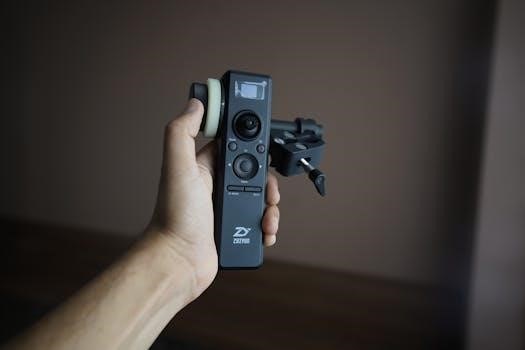100 amp manual transfer switches are essential for safely connecting a portable generator to a home or business. These switches facilitate the transfer of power between the utility grid and a backup generator during outages. They come in various configurations, including single-phase and three-phase options.
What is a Manual Transfer Switch?
A manual transfer switch is a device that allows users to safely switch between two power sources⁚ the utility grid and a backup generator. Unlike automatic transfer switches, manual versions require human intervention to initiate the transfer. These switches are crucial for preventing backfeeding, a dangerous situation where generator power flows back into the utility lines. Manual transfer switches offer a cost-effective solution for managing power during outages, ensuring a safe and controlled transition between power sources, especially in residential and light commercial settings that use 100 amp electrical services.
Types of 100 Amp Manual Transfer Switches
100 amp manual transfer switches are available in single-phase and three-phase configurations; They also come in service entrance and non-service entrance models, each designed for specific installation requirements and applications.
Single-Phase vs. Three-Phase Options
When selecting a 100 amp manual transfer switch, understanding the difference between single-phase and three-phase options is crucial. Single-phase is typically used in residential settings, while three-phase is more common in commercial or industrial applications. Single-phase systems involve two hot wires and a neutral, suitable for most household appliances. Three-phase systems utilize three hot wires and a neutral, delivering higher power, and are necessary for heavy-duty equipment. Choose the switch based on the electrical service of your building and the generator output.
Service Entrance vs. Non-Service Entrance
100 amp manual transfer switches are available in service entrance and non-service entrance configurations. Service entrance rated switches include a main circuit breaker and can be installed before the main electrical panel, allowing for complete power transfer. Non-service entrance switches are installed after the main panel, requiring a separate main disconnect. The choice depends on local codes and the specific electrical setup of your property. Service entrance options often simplify installation, while non-service entrance options may be more suitable for specific panel configurations.

Installation of a 100 Amp Manual Transfer Switch
Installing a 100 amp manual transfer switch requires careful attention to wiring and safety protocols. It is recommended that a certified electrician handle this process to ensure compliance with electrical codes.
Wiring Considerations and Diagrams
Proper wiring is crucial for the safe and effective operation of a 100 amp manual transfer switch. Wiring diagrams must be carefully followed to ensure correct connections between the utility power, the generator, and the load. Considerations include wire gauge, insulation type, and proper grounding. Diagrams typically show the connections for the line, load, and neutral wires. It’s important to use appropriately sized lugs for secure connections. Incorrect wiring can lead to equipment damage or personal injury. Always double-check all connections.
Safety Guidelines During Installation
Safety is paramount when installing a 100 amp manual transfer switch. Always disconnect power before beginning any work. Wear appropriate personal protective equipment, such as insulated gloves and safety glasses. Ensure the work area is clear and well-lit. Carefully follow the manufacturer’s installation instructions and local electrical codes. Double-check all wiring connections before restoring power. Avoid working when fatigued or distracted. If unsure, consult a qualified electrician. Never install a damaged transfer switch, as it could lead to serious injury or equipment damage;

Operation of a 100 Amp Manual Transfer Switch
Operating a 100 amp manual transfer switch involves manually switching between power sources. This is done by moving a lever or switch to select either utility power or generator power, ensuring a safe transition.
Switching Between Power Sources
Switching between power sources with a 100 amp manual transfer switch requires a deliberate manual action. Users must move the switch to the designated position for either the main utility power or the backup generator. It is crucial to ensure the generator is running and stable before switching to generator power. Likewise, when transitioning back to utility power, confirm that utility power is restored and stable. The manual switch ensures a break-before-make action, preventing backfeeding and protecting equipment. This process is simple but requires careful attention for safety.
Safety Features and Standards
100 amp manual transfer switches adhere to safety standards such as NEMA ratings and UL certifications. These ensure protection against environmental factors and compliance with electrical safety codes, guaranteeing reliable performance.
NEMA Ratings and UL Certifications
NEMA (National Electrical Manufacturers Association) ratings, such as NEMA 3R, indicate the enclosure’s protection against environmental conditions like rain and ice. UL (Underwriters Laboratories) certifications signify that the transfer switch has been tested and meets safety standards. These certifications are crucial for ensuring the device’s safe operation and reliability. Adherence to these standards helps to minimize the risk of electrical hazards and ensures the safe transfer of power during outages, providing peace of mind to the user. It is important to verify these ratings before purchase.

Maintenance and Troubleshooting
Regular inspections of a 100 amp manual transfer switch are vital for ensuring its proper function. Part replacement, when needed, should be done promptly using manufacturer-approved components. This prevents operational issues.
Regular Inspections and Part Replacement
Regularly inspecting your 100 amp manual transfer switch is crucial for maintaining its safety and operational reliability. Check for any signs of wear, corrosion, or loose connections. Ensure that all wiring is secure and that the switch operates smoothly. Any worn or damaged components should be replaced immediately with manufacturer-approved parts. Prompt replacement prevents potential failures and ensures the switch can function correctly during power outages. Following these maintenance steps ensures long-term safety and efficiency.

Popular Brands and Models
Several reputable brands offer reliable 100 amp manual transfer switches. Generac, Briggs & Stratton, and GE are well-known for their quality and durability. These brands have a variety of models to suit different needs.
Generac, Briggs & Stratton, GE
Generac offers models like the 6334, known for reliable power control. Briggs & Stratton provides automatic transfer switches, some with service disconnects and Symphony II power management systems, though they also produce manual options. GE’s 100 amp non-fused emergency power transfer switches, with NEMA 3R enclosures, are UL listed and ANSI certified for safety. These brands offer a range of solutions for residential and commercial backup power needs, with varying features and installation requirements. Each brand aims to provide safe and efficient power transfer during outages, focusing on user-friendly designs and robust construction.
Applications of 100 Amp Manual Transfer Switches
100 amp manual transfer switches are used in both residential and commercial settings. They provide a safe method to switch between utility power and backup generator power during electrical outages, ensuring critical systems remain operational.
Residential and Commercial Use
In residential settings, 100 amp manual transfer switches are commonly used to power essential appliances like refrigerators, lighting, and heating systems during power outages. For commercial applications, these switches support critical equipment such as servers, refrigeration units, and security systems. They are crucial for maintaining business operations and ensuring safety when grid power is interrupted. These switches are also suitable for single-phase applications. They also facilitate the use of backup power, whether from generators or other sources, for both homes and businesses.
Considerations When Choosing a 100 Amp Manual Transfer Switch
Selecting a 100 amp manual transfer switch requires matching generator output with the load requirements of the circuits to be powered. Compatibility with single-phase or three-phase systems is also a key factor.
Matching Generator and Load Requirements
When choosing a 100 amp manual transfer switch, it’s crucial to ensure the generator’s output capacity aligns with the total electrical load you intend to power. Overloading the generator can lead to damage or system failure. Calculate the combined wattage of all appliances and circuits to be connected, and select a generator and transfer switch that can handle this total load. Proper matching is vital for safe and reliable backup power. Be sure to account for startup surges, especially for motors and compressors.
Additional Features and Options
100 amp manual transfer switches offer various enclosures for different environments, like outdoor and indoor options. Look for features like NEMA ratings for protection against weather and other elements. These choices ensure safe and reliable operation.
Outdoor and Indoor Enclosures
When selecting a 100 amp manual transfer switch, the enclosure type is crucial. Outdoor enclosures, often rated NEMA 3R, are designed to withstand weather elements like rain and snow, ensuring the switch’s longevity. Indoor enclosures are suitable for sheltered environments, focusing on protecting the switch from dust and accidental contact. Choosing the correct enclosure is essential for the safety and proper functioning of the transfer switch based on its installation location. It is important to select the appropriate enclosure for your specific application. This will guarantee optimal performance and protection.

Leave a Reply
You must be logged in to post a comment.